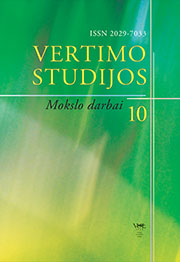SVETIMŽODŽIŲ PERTEIKIMAS VERČIANT GROŽINĘ LITERATŪRĄ. ATVEJO ANALIZĖ
TRANSFER OF FOREIGNISMS IN TRANSLATIONS OF FICTION/ IN FICTION TRANSLATION . A CASE STUDY
Author(s): Rasa KlioštoraitytėSubject(s): Theoretical Linguistics, Translation Studies, Theory of Literature
Published by: Vilniaus Universiteto Leidykla
Keywords: Foreignisms; Translation of fiction;
Summary/Abstract: Foreignisms are used in fiction for different purposes and perform different functions. Translators of fiction from one language and culture into another have to make certain decisions as to how to render these words and phrases into the Target Text, in order to retain the functions they serve in the Source Text and keep the reader in the know of their meaning. The article gives a picture of how foreignisms are approached by Italian researchers, especially as regards their functions in the text. A case study is based on the analysis of the use of foreignisms in the book Gerico 1941. Storie di ghetto e dintorni (2010) by Igor Argamente, an Italian writer of Polish origin, born in Vilnius, Lithuania, and its translation into Lithuanian (Jerichas 1941 metais. Vilniaus geto istorijos), translated from the Italian by Toma Gudelytė (2014). The study has revealed that the author was not consistent in using foreignisms in his text, choosing different ways of their presentation. The translator has followed his technique in the majority of cases, transferring foreignisms into the target text with the help of graphical, phonetical and morphological adaptation; in other cases graphical and phonetic adaptation was employed, but morphologically they remained unchanged. The third option was not to adapt these words or phrases at all, but explain them in intratextual (next to the word/phrase used) or extratextual commentaries (in footnotes), which means that there is no single way of presenting foreignisms either in the Source Text or in the Target text. However, following Umberto Eco, the translator should follow the ways the author chose and not to embellish the Target Text, but should also be consistent in his/her own strategy in those cases were the choice is that of the translator and be consistent throughout the translation.
Journal: Vertimo studijos
- Issue Year: 10/2017
- Issue No: 10
- Page Range: 175-191
- Page Count: 17
- Language: Lithuanian

